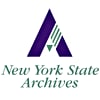Källinformation

New York, USA, personakter upprättade i hem för krigsveteraner, 1897-1963
This collection consists of case files for individuals who applied and gained admission to the New York State Veterans’ Home in Oxford, formerly known as the New York State Woman’s Relief Corps Home. The files are grouped into three chronological periods based on the resident’s death or discharge date (prior to circa 1920, circa 1920–1957, or circa 1957–1963), and are arranged alphabetically therein by last name.
Historical Background
In 1894, the New York State Woman’s Relief Corps Home (later the New York State Veterans’ Home) was established to provide for aged dependent veterans and their wives, veterans’ mothers, veterans’ widows, and army nurses who suffered from a “physical disability or other cause” that rendered them unable to care for or provide for themselves. Unlike the New York State Soldiers’ and Sailors’ Home in Bath, N.Y., which housed only male veterans, this facility opened its doors in May 1897 to women who served either as wartime nurses or who were related to honorably discharged male veterans. Male veterans were allowed to apply for admission, provided that they were married and were accompanied by their wives when living at the Home.
While admission to the Home was originally restricted to Civil War veterans with their wives, veterans' widows, and army nurses, later legislation expanded the eligible applicant pool to include the following groups: Spanish-American War veterans with their wives and these veterans’ widows and mothers; daughters of Civil War veterans; World War I veterans with their wives and these veterans’ widows and mothers; as well as veterans of the Philippine-American War with their wives and these veterans’ widows, mothers, and daughters.
The site chosen for the Home was located in the Village of Oxford, in Chenango County. When the facility opened, it housed only 24 residents in a single building; by 1911, the Home had expanded to include 172 residents living on a campus with five buildings, including four cottages and an infirmary.
About the Records
The records pertaining to each resident consist of an envelope on which is summary information about the resident, which may include the following: case number, name, company, regiment, arm of service, when admitted, when discharged, cause of discharge, and remarks. While the contents of the case files vary, each contains the completed application form for admission into the Home. The format of the application often varies depending on the time period and whether the applicant was a male veteran; a widow, mother, or daughter of a veteran; or a female nurse. Yet, each usually includes the following sections: statement of the applicant (name, date of birth, birthplace, address, relationship to veteran—for female applicants, nature of disease or disability, amount of real estate owned, total income, pension income, nearest relative, reason for applying to the Home); record of the veteran’s service (war served in, rank, company, regiment, date of enlistment, date of discharge, reason for discharge, and places of enlistment/discharge); certificate of identification before a notary public; and surgeon's certificate, where a doctor described and verified the applicant’s disability, which would have prevented him or her from earning “subsistence by manual labor.”
In addition to the application form, most case files include letters authored by the resident, resident’s family members, the Home’s superintendent, and/or other parties such as insurance companies and the Grand Army of the Republic (GAR). The correspondence generally concerns the resident’s admission to the Home, sometimes elaborating on the reasons why the applicant desired to apply; life while at the Home; and death or discharge from the Home, including the disposition of the resident’s belongings. Other items often found in the case files include military documents, such as discharge papers or pension certificates, which were used by the Home to verify requirements for admission; court documents; copies of marriage and death certificates; bills and receipts; and insurance papers.
Description courtesy the New York State Archives catalog.